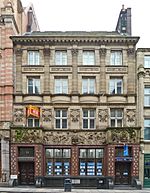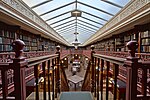The Headrow

The Headrow is an avenue in Leeds city centre, West Yorkshire, England. It is one of the most important thoroughfares in central Leeds, hosting many of the city's civic and cultural buildings, including Leeds Town Hall, Leeds Central Library, Leeds Art Gallery, The Henry Moore Institute, and The Light. Some of the largest retail floorplates in the city are on The Headrow, particularly between Park Row and Briggate, where major chains have opened flagship stores. The Headrow is part of a longer axis that includes Westgate, Eastgate, and Quarry Hill. The Headrow forms a spine across the city centre between Westgate and Eastgate and is approximately ½ mile (700 m) long. It was widened between 1928 and 1932 in a redevelopment designed by architect Reginald Blomfield, primarily as a way of improving traffic flow through city centre. The area has an advisory speed limit of 15 miles per hour (24 km/h). The section between Park Row and Briggate is reserved for buses and taxis and cars/motorcycles are not permitted to use it between 5 a.m. and 10 p.m.
Excerpt from the Wikipedia article The Headrow (License: CC BY-SA 3.0, Authors, Images).The Headrow
Albion Street, Leeds Lovell Park
Geographical coordinates (GPS) Address Nearby Places Show on map
Geographical coordinates (GPS)
| Latitude | Longitude |
|---|---|
| N 53.7995 ° | E -1.545 ° |
Address
Albion Street
Albion Street
LS2 8TP Leeds, Lovell Park
England, United Kingdom
Open on Google Maps











